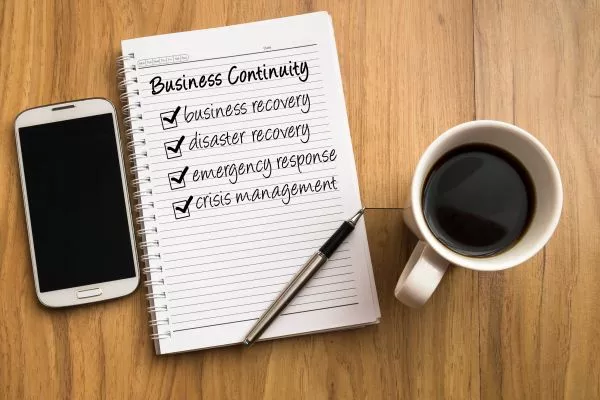No company is immune to disasters. Disruptions can occur out of nowhere and have crippling consequences for organizations of any size. From a loss of productivity and revenue to damaging reputation and customer relationships, the impact can be catastrophic. That's if you're unprepared!
A comprehensive business continuity plan will make sure you stay up and running no matter what disasters come your way. Properly executed, it is the most reliable way to ensure that your operations continue to run with seamless efficiency. The following checklist will help technology companies, healthcare providers, and organizations in any field streamline their business continuity planning efforts.
Download Checklist PDF 

The Complete Business Continuity Checklist
Below we've summed up the points that our business continuity checklist is based on. Be aware that you can use this as a starting point for a comprehensive preparedness plan. Disaster recovery strategies, however, will vary depending on each organization's specific structure, systems and environments, even geographical location, as well as the severity and nature of the disaster situation.Assemble the team
Business continuity is certainly the type of project that warrants its own team. Build your team with hierarchy in mind so each member knows their roles and which recovery tasks they're responsible for. Ideally, this team will address all of your BC plans from preparation to execution.
Draw up the plan
One of the most important components of a business continuity plan is actually mapping out a strategy. Use this opportunity to identify key processes and people that keep the business running. Make a list of all the disruptions that could potentially hinder your operations. Pinpoint the functions that are most critical to everyday business processes, and formulate practical recovery strategies for each possible disaster scenario.Conduct business impact analysis
Once you've identified all the potential threats to your daily operations, it's time to analyze the impact of those threats. Depending on your set-up and geographical location, you may need to think of an extensive list. This can include: flood, fire, hurricane, earthquakes, tsunami, volcano. These will be natural disasters that may hit once in a lifetime, however there are others which have a higher probability of happening. Statistics show that it's very likely to experience downtime due to: power outage, hardware or system failure, data corruption, cyber attacks or even accidental or malicious data deletion by employees. A flood may cause water damage that requires replacement of servers and other equipment, while a fire could result in a situation where you're forced to close down. Your business continuity team and management personnel should understand all the problematic scenarios that may accompany a disaster, and how those situations could affect the organization as a whole. You should identify a disaster situation budget. This means at any given time, you should know how much downtime costs your business.Read More: Can You Afford Downtime?Educate and train
Just because your staff is proficient at IT and cyber security doesn't necessarily mean they can always handle business continuity. School the team on the objectives, requirements, and key components of your BC plan, then create a training program that helps them develop the skills needed to execute that strategy.Isolate sensitive info
Some data is so important that losing it could put your entire business in jeopardy. You should keep financial records, login credentials, and other mission-critical information somewhere that allows for quick and convenient access during recovery. You want to prioritize the data that is most vital to the continuity of your business.
Backup important data
A good backup plan entails creating copies of anything that can't be replaced. For an MSP, that may include document files, employee and customer records, business emails, and even select data stored on mobile devices. If a disaster happens today, an effective backup strategy can make sure you're back in business tomorrow - or on the same day.Protect hard copy data
IT security strategies tend to focus on electronic data. However, most companies still have their fair share of physical documents to maintain. The typical MSP has an assortment of contracts, tax documents, and employee files that are just as important to business operations as the data on their hard drives. Digitize what you can and put security controls in place to minimize the loss of critical documents.Designate a recovery site
A disaster could literally wipe out your data center. Prepare for the worst by designating a secondary site your staff can relocate to should the primary site become inoperable. You should equip this location with everything personnel needs to recover affected systems and perform business processes.Set up a communications program
The ability to communicate in a crisis situation is crucial. In addition to a list of emergency contacts, consider drafting sample messages ahead of time to expedite communications to partners and suppliers in crisis scenarios. A detailed communications plan will allow your BC team to coordinate their efforts and respond accordingly.Test, measure, and update
You should test and measure every important business program for effectiveness. A business continuity plan is no exception. The purpose of testing is to run simulations that allow you to evaluate your team's level of preparedness. Those test results can be used to tweak and update your plan over time. Business continuity planning ensures that disruptions have minimal impact on day to day operations. Now that you have an idea what needs to be done, you can make sure your organization is ready for anything. We've put together a .pdf with your business continuity checklist, so you can use it anytime you need. Download the StorageCraft business continuity checklist here.You May Also Like
- Uncategorized
5 Steps to Building an Effective Ransomware-Free Data Protection Strategy
July 5th, 2021 - Business Continuity Uncategorized
Arcserve & StorageCraft: The New Business Continuity Leader
February 24th, 2021